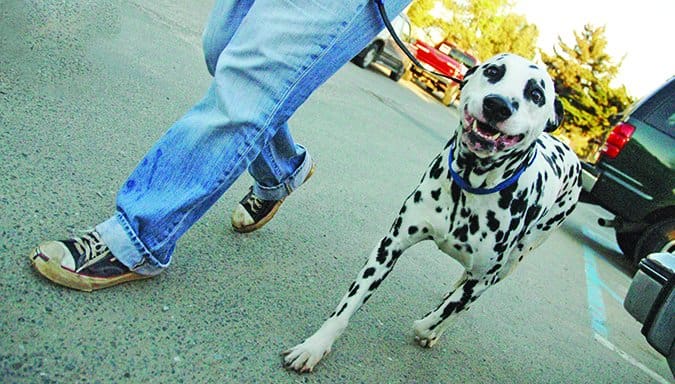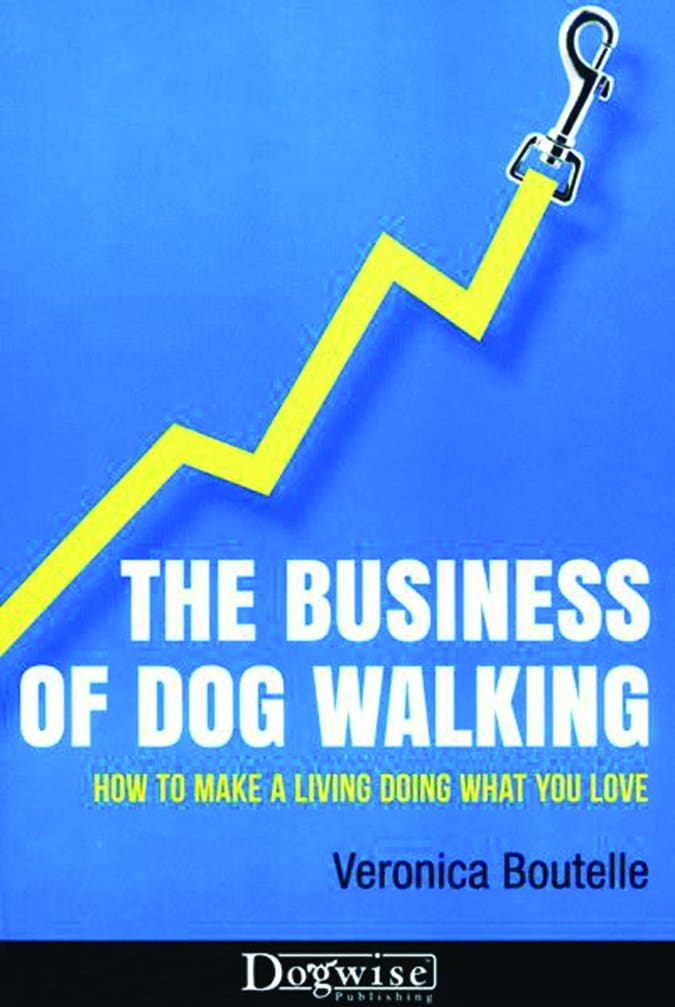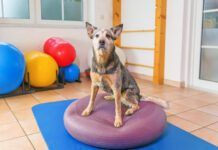I can’t even count the number of horror stories I’ve heard about ill-equipped, inexperienced, and downright irresponsible dog walkers. I’ve heard about dogs who were traumatized, injured, and even lost by dog walkers – which is why I’m always surprised when someone I know hires a random dog walker advertising their services on an app or from a bulletin-board flier without checking their references or interviewing them first. Would you hire a babysitter for a child this way? No!

“Professional dog walking has grown rapidly over the past 10 years,” says Boutelle, former director of Behavior and Training for the San Francisco SPCA. But, she adds, it’s a young business. “There is currently no regulating body and anybody who wants to go into the business can hang out a shingle. But walking dogs, particularly in groups, takes more than the passion we all share for them. There is specialized knowledge and skill that walkers should possess to ensure the safety of the dogs in their charge, as well as themselves and the other dogs and humans who share the beaches, trails, and parks.”
That’s why Boutelle launched the Dog Walking Academy (DWA), the only organization that offers certification in dog walking, as one of the first programs of dog*tec, a company she founded in 2003 to help dog professionals succeed in their businesses. The DWA curriculum covers learning theory, canine body language, aggression, fight protocols, basic dog training, leash handling, pack screening and management, as well as successful business practices.
To become a dog*tec Certified Dog Walker, candidates must successfully complete an intensive training program, pass a hands-on practical exam and a comprehensive written exam, be certified in first aid, and pledge to use only humane, scientifically sound training approaches and ethical business practices. Through this commitment to excellence, the DWA is helping to establish the standards of this young profession.
Go with a Professional Dog Walker
Many of us are too busy keeping a roof over our own and our dogs’ heads to walk our dogs as far as they need to go daily. That’s where professional dog walkers can be of assistance. Whether individuals or a part of a dog walking business, professional dog walkers provide an on-going scheduled service for those of us who are not able to get our canine companions out for regular excursions, be it an on-leash walk, off-leash hike, or romp in a local dog park.
Dog walking is not a vacation pet sitting service or a general pet care service, though many dog walkers offer these additional care options. There are varied approaches to dog walking and the types available will be largely dictated by geographical location. In the San Francisco Bay Area, for instance, dog walking usually refers to walking small groups of dogs off leash on beaches, trails, or in parks. In New York City, it tends to be associated with walking groups of dogs on sidewalks. And in most urban and suburban areas, dog walking means single dog or small group on-leash walks in your neighborhood.
What all professional dog walking services have in common is the ability to get your dog good and tired, and return him safely to your home, on a schedule you choose: once or several times a week, or daily, if need be.
Our dogs benefit from regular exercise, just like we do. Physical activity can help with disease prevention, joint stability, flexibility, and cardiovascular health. Regular outings elevate a dog’s mood, stimulate his mind, relieve boredom and stress caused by inactivity, and provide social interaction and environmental enrichment.
The human client benefits, too, with relief from guilt and the worry that the dog is tearing up the sofa from boredom or anxiety. There is nothing like the peace of mind you get from knowing your dog is out having a great time and getting the exercise he needs! One also hopes for a better-behaved, relaxed, content dog to come home to at the end of the day. These benefits are profound and contribute to a happier, healthier life.
Choosing a Dog Walker

Obviously, it’s most important to find someone who will take great care of your dog. Again, anybody can call herself a dog walker, so it’s up to you to determine whether or not the person is truly qualified. Once you’ve located an individual dog walker or dog-walking business, interview the person who will actually walk your dog. Your dog should be present so you can view how the walker interacts with him and so you can assess how he feels about the walker.
A good dog walker (or the representative from a dog walking company) should have good answers to all the following questions:
1. Who will actually walk your dog?
Some companies are very small, with the sole proprietor serving as the sole dog walker; some might have dozens of walkers. Does the business employ independent contractors or employees? How are they screened?
2. What is the background of the person (or people) who will walk your dog?
How much and what kind of training have they had in dog walking? Have they had any education in canine learning theory, body language, and pack management?
Ideally, you want someone with professional training and knowledge and the skill set to implement this knowledge. They should use scientifically sound humane training methods and know how to assess and group dogs for maximum compatibility. They also need to be able to interpret canine body language, handle any issues that arise, take appropriate steps to prevent fights, and have the ability to properly break up a fight if one occurred – or protect your dog in case of an attack by a random dog on the street!
For these reasons, you should be advised anytime one of the walkers that you have approved is not available; don’t allow the company to replace your approved walker (without your knowledge) with an employee who lacks the qualifications you had sought out.
3. How many dogs do they walk at once?
Walkers may escort a single dog or as many as 20. Whether on- or off-leash, each dog added to a group increases the potential for conflict, injuries, lost dogs, and distraction, and makes it improbable that your dog will receive much individual attention.
Remember, the walker has only two eyes, two hands, and two legs. Some cities, counties, and park districts regulate the number of dogs a walker can take out together. Certified dog*tec walkers may walk no more than eight dogs at a time if they want to maintain their certification. Ask for private or semi-private (just your dog and one other compatible dog) outings if your dog is not suitable for or does not enjoy group walks.
4. What is the protocol for screening dogs who will be walked together in groups?
How are they grouped? By age, size, activity level? Because it can be easy for small dogs to be injured by one of their larger buddies, insist that your dog is only walked with other dogs about the same size (stick to the 50 percent rule: cohorts should not weigh more than double that of any other one in the group).
5. How will dogs that will be grouped together be introduced?
And what kind of management methods do they use? Not all dogs have good social skills or self-control. Your walker should know how to keep (and be capable of keeping) a group of dogs under control and safe without the use of fear, intimidation, or pain.
6. Where will your dog be walked?
Is the walker familiar with the local rules and regulations? Some areas that allow dogs have specific requirements for dog walking professionals, such as limiting the number of dogs allowed to be handled by one walker.
7. What kind of activities will your dog be engaged in? On-leash or off-leash?
Your dog shouldn’t be allowed off-leash if she doesn’t have a reliable recall, and any new walker should spend at least a few walks with her on-leash before she is allowed off-leash. If your dog doesn’t currently have a good recall behavior, don’t despair; a really good walker will have a protocol for both training a recall and for keeping your dog safe until your dog’s recall is reliable.
8. Will the person walk your dog in your neighborhood, or transport her elsewhere?
The walker must have an appropriate vehicle, and the dogs inside the vehicle should be safely restrained (with crates or body harnesses and seat belts or tie-downs) during transport. (We saw a nightmare story not long ago about dogs being tied by their collars in a big van; one dog broke her neck during transport by a dog walking company.)
When multiple dogs are being picked up and dropped off during transport, are the dogs left alone in a vehicle, and if so, for how long? (Client dogs should never be left in a vehicle while the walker participates in an interview with a prospective new client, for example. They should be left for only the minute it takes to bring a client’s dog back into their own home.) And is the vehicle always securely locked, so that no one could come along and release or steal the dogs inside?
If on foot, are dogs secured outside during the pick-up/drop-off process? Tying up dogs and leaving them alone is not an acceptable practice.
9. How much time do they guarantee on a walk?
Confirm that this time is exercise time and does not include any transportation time.
10. What equipment does the walker want on your dog?
Some dog walkers prefer to use their own equipment for a variety of reasons. (This keeps them from having to search their clients’ homes if the dog’s own equipment can’t be located, avoids damaging or dirtying the client’s gear, and ensures proper, correctly sized equipment.) That said, you should not give them permission to use equipment that you do not approve of, or that your dog finds aversive. Ideally, the walker uses your well-fitted equipment, outfitted with secure, up-to-date ID, and you make sure it is in good condition and ready at the door for the walker.
11. What kind of incidents has the dog walker encountered?
Have any dogs in her care been lost or injured? Safety should be a primary concern. Optimally a walker has been trained in pet first aid and emergency protocols. He should carry a cell phone and have your telephone numbers programmed into it.
What will your walker do if your dog is injured? He should know the location of the emergency clinics in the area as well as your dog’s vet and keep a signed veterinary release form on hand in case your dog needs medical attention and you’re not available. What will be done with your dog if another dog in the group is injured and requires your walker’s full attention? What if the transport vehicle breaks down? If a dog is lost? A natural disaster occurs? Is the walker prepared? If you don’t ask, you won’t know.
12. What if your dog walker cannot make it at the scheduled time?
Is there a back-up walker? If you count on the walking service to provide a potty break for a dog who can’t hold it all day, the walker’s reliability (or backup) needs to be impeccable.
13. Will inclement weather be cause for cancellation?
Is your dog walker familiar with the effects of inclement weather (heat, snow) on dogs and how to take precautions? Some walkers in areas with extreme weather provide alternative services when such conditions are present, such as potty breaks and indoor playtime and/or the use of interactive toys (stuffed Kongs, puzzles).
14. Will they provide a walk report?
Some walkers will leave you a note to let you know how your dog did during the outing as well as any observations or incidents.
15. Do they have references?
If so (and they should), check some! Don’t skip this important step. If each client you call has caveats or concerns about the service, choose another provider.
Ask to observe your prospective walker on an outing to make sure you’re comfortable with how she treats dogs in her care. Be aware that most group dog walkers won’t allow a client to accompany them in order to prevent their attention being diverted from the dogs. They shouldn’t mind you observing, however. If you’re hiring a walker for private outings, offer to pay her for a trial run with your dog and follow along.
16. Is the walker licensed, insured, and/or bonded?
Some cities and counties require professional dog walkers to be licensed and/or bonded. Licensing generally refers to having a standard business license, usually issued by the city in which the business exists. Check with your local regulating agencies to see if there are any special regulations for dog walkers.
In San Francisco, for example, walkers are required to obtain a license from the San Francisco Animal Care and Control in order to use city lands for professional dog walking. This city legislation is the first of its kind and it requires dog walkers to complete a training program like the DWA. Liability insurance is a must. Bonding (a bond provided by an insurance company) protects against damage that might be caused while performing a service; a walker may not need to be bonded if his insurance covers him in the same way.
17. Does the walker have a written service contract explaining services and payment policies?
Ideally the service should provide you with a contract to sign. Read it carefully.
18. Most important of all: Does the walker like your dog and does your dog like the walker?
Is the walker’s interaction with your dog gentle and kind? Does your dog want to interact with the walker? If your dog is normally shy, does the walker respond appropriately?
More Considerations
Keep in mind that the outing is for your dog. Above all, she should have a good time and get some exercise. If your dog is older and has health problems, the walk may just be a leisurely sniff and stroll. A good dog walker will assess an individual dog’s needs and adjust accordingly.
While many walkers have excellent training skills, the outing isn’t intended to be a training session; however, a good walker though should be able to follow any training protocols you have in place, and prevent your dog from developing any bad habits while out and about.
Know your dog and communicate what you know to your walker. Teach your dog a strong “leave it” to assist the walker in preventing your dog from picking up or eating inappropriate or dangerous items while out and about.
Speaking of eating, let your walker know of any dietary restrictions or food allergies. Inform the walker if your dog has been experiencing any changes in behavior or health (limping, lethargy, decreased appetite, etc.).
Always let your walker know if something out of the ordinary has occurred in between walks (a scare or a scuffle with another dog, for example) so he can keep an eye out for any side effects. In turn, listen to your walker if he expresses concerns about your dog’s health or behavior, or recommends or requests that you hire a trainer or visit your veterinarian.
And don’t forget to listen to your dog: if you begin to notice that your dog is not happy to see the walker and excited to go with him, it may be time to find a different walker or different type of activity for your dog.
Be aware of your walker’s cancellation policy and follow it. Understand that cancelling a scheduled walk has an impact. Walkers take only a small number of clients at a time and therefore a cancellation can represent a significant impact on their income. Remember, too, that walkers are not on call 24 hours; respect their hours and limit all but emergency calls to the work day.
Keeping Your Dog Happy
Dog walkers make a valuable contribution to the quality of life of the dogs they serve. Instead of being home alone all day, these dogs are given the much needed exercise and social interactions that they might not otherwise get. This contributes to their health and happiness, which in turn can help keep them safe and in permanent homes. Studies show that many dogs are relinquished because of normal expressions of boredom or lack of exercise, such as barking, chewing, destructive behavior, etc. Our canine companions are doing their best to adapt to our modern lifestyles; the least we can do is to take their well being to heart.
What About a Dog Runner?
Have a super high-energy dog, or a canine athlete who needs to maintain a high level of fitness? Consider a dog runner! These specialty dog walkers will run with your dog; most of them are marathon or ultramarathon runners who are perfectly comfortable taking your dog out for more miles than you can handle. Running is perfect for burning off an athletic dog’s excess energy or shedding excess weight from an overweight athlete (again, make sure your dog is in good health first).
Some running services even track your dog’s run with a GPS and then upload the information to a website so you can view the details of the run, including pace, total time, elevation, mileage, and a map of the run.
Dog runners need to do everything that dog walkers do, and also know how to interpret your dog’s well being, monitoring for signs of heat exhaustion, fatigue, or injury.
Ultramarathoner Bob Halpenny runs daily with dogs on the trails near Sacramento, California. For more information, see www.onthetraildogfitness.com.
Considering Becoming a Professional Dog Walker?

From the introduction to The Business of Dog Walking, by Veronica Boutelle (Reprinted with permission, copyright 2014 Dogwise Publishing; available for purchase in hard copy or ebook from dogwise.com)
“It’s a lot more complicated than people realize. Factor in squirrels, cats, and other dogs. Consider dogs with leash reactivity or a fear of strangers. Or dogs who like to chase things, including bicycles and skateboards. Imagine little kids with outstretched hands and adults with fear on their faces. Then throw in narrow sidewalks and off-leash trails…
“Still interested? Get educated and certified. Learn: canine body language, pack composition and management techniques, building reliable recalls, fight prevention and protocols, canine first aid, business practices. Start: a legitimate business with required licenses and documentation. Obtain: professional insurance. Research: rules and regulations for dogs and dog walking in your area. Talk: to other walkers to learn of their experiences. Ask: to observe or intern with walkers for hands-on experience. Consider: attending dog*tec’s Dog Walking Academy, now offered in at least 14 cities in the US as well as cities in Canada and New Zealand.





Choosing a Dog Walker with apps
Very nice post. This will allow dog owners to leave their dogs safely with the dog walkers.
Dog walking services are very important for maintaining peace of mind and health of the dog.